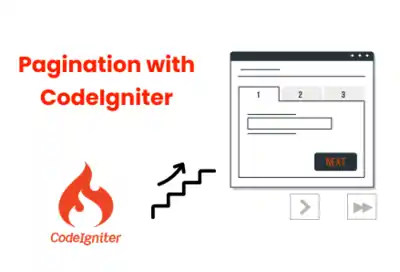Home - Scripts - Website Development

CodeIgniter’s pagination library improves user experience by dividing large data into pages, reducing load times and increasing website responsiveness. Widely adopted in PHP frameworks.
Key Points
With Over 14 years of Experience in the IT Field, Helping Companies Optimise there Products for more Conversions

Pagination is an essential feature for any modern web application, especially when dealing with large datasets. In the context of custom web development, implementing efficient pagination helps improve performance, user experience, and scalability. If you are a website development company, understanding how to integrate pagination in CodeIgniter 4 is a valuable skill. This guide will walk you through the process step-by-step, integrating Bootstrap 5 for a clean, responsive design.
The foundation of pagination starts with a database table. For this example, we create a users table that stores user information such as name, email, phone number, and additional details.
To demonstrate pagination, you need a dataset to work with. This is crucial in custom web development projects where displaying large records on a single page is impractical.
Use the CodeIgniter CLI Tool to Create the Migration. Run the following command in your terminal:
Creating this database structure ensures that your backend can efficiently retrieve and manage user data, a fundamental step in delivering quality website development services.
Before working with user data, you need to create a database table where the user records will be stored. In CodeIgniter 4, migrations provide a convenient way to manage your database schema in a structured and version-controlled manner.
Discover why moving your site from WordPress can enhance performance and scalability for your business.
Navigate to app/Database/Migrations and open the newly created migration file.
Inside the migration class, update the up() and down() methods to define the schema for the users table:
After updating, run this command to execute the migration and create the table:
The Model in CodeIgniter acts as the interface between the database and the controller. In this case, the UserModel encapsulates all user-related database operations.
The model fetches user records, limiting the data per page using CodeIgniter’s built-in paginate() method. This function automatically calculates the required offsets and limits, making it simpler to implement pagination. Use the CodeIgniter CLI Tool to Create the Model. Run the following command in your terminal:
After creating the Model, open the app/Model/UserModel.php file and update it with the following code.
$table property specifies the database table name.
$allowedFields secures which fields can be updated or inserted.
$useTimestamps ensures that record timestamps are maintained automatically.
Using paginate(10) tells the model to fetch 10 records per page.
By managing database queries efficiently, the model contributes significantly to the performance of your web application — a key consideration for any website development company offering robust custom web development solutions.
Controllers in the MVC architecture receive requests, process data, and load views. The UserController handles pagination requests and passes the necessary data to views.
Loads the UserModel instance.
Calls $this->UserModel->paginate(10) to fetch user data limited to 10 records per page.
Retrieves the pager instance to generate pagination navigation links dynamically.
Passes both user data and pager objects to the view.
Use the CodeIgniter CLI Tool to Create the Controller. Run the following command
in your terminal:
After creating the controller, open the app/Controllers/UserController.php file and update it with the following code.
This separation of concerns enables your website development services team to maintain clean, manageable code, helping you deliver scalable and maintainable websites to your clients.
The route configuration maps URLs to controller functions, enabling users to navigate through paginated data seamlessly:
Setting up clean, intuitive routes is essential for any website development company striving for SEO-friendly and user-centric web applications.
The view is the front-facing part of the pagination system. It displays user data in a table format and includes pagination navigation using Bootstrap 5 components for a polished look.
Dynamically loops through the paginated user's data and displays it in a table.
Shows a message if no users are found (important for UX).
Uses $pager->links() method to automatically generate pagination links styled with Bootstrap classes.
Includes custom CSS to enhance the look and feel of pagination buttons, including hover effects.
Bootstrap 5 offers responsive, mobile-friendly components that ensure your website looks great across all devices, a necessity in modern custom web development projects.
Implementing pagination in CodeIgniter 4 is straightforward yet powerful for handling large datasets in your web apps. Coupled with Bootstrap 5, it not only enhances usability but also adds a professional polish to your projects.
If you offer website development services integrating this feature will significantly boost the performance and appeal of your web applications.
Whether you're a developer or a website development company, leveraging these techniques ensures your projects are both user-friendly and efficient.

©2025Digittrix Infotech Private Limited , All rights reserved.